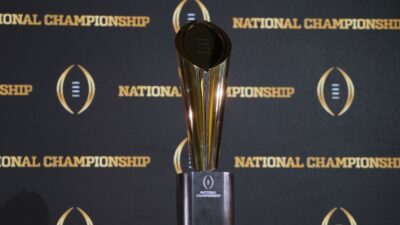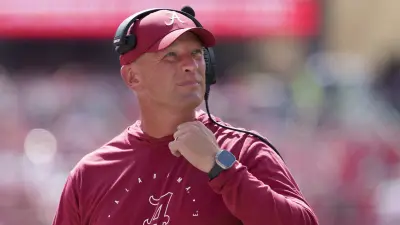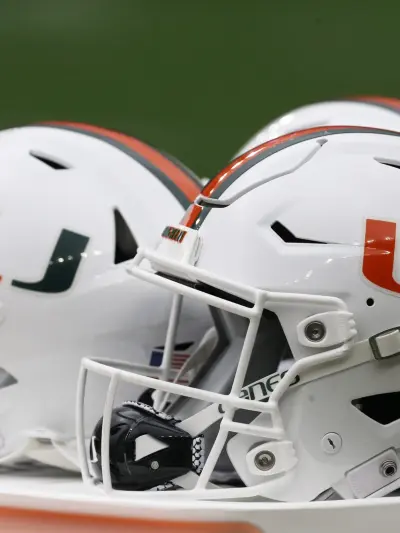By Alec Nederveld
Every year, millions turn to CBS, TBS, TNT, and TruTV to watch March Madness. Both casual and diehard fans love the event, with all the Cinderella stories, upsets, and high-level basketball. The tournament is iconic and takes over the country, unlike any other athletic event.
Like most playoffs, March Madness has grown over time. The tournament originally started with eight teams and most recently jumped to 68 in 2011. Recently, there has been traction to increase the field to as many as 96 teams, although an expansion to 72 or 76 is more likely. TV executives see the gold mine they have and try to dig even deeper, except to the point where the mine breaks.
Does that sound familiar? College Football, with a history of different National Championship selection models, has gone into a similar spiral of greed, albeit not limited to the postseason tournament. The CFB Playoff, which originated with four teams in 2014 will jump to 12 for this upcoming season. The 12-team playoff “era” won’t last for long, however. In 2026, the playoff will feature 14 teams.
Approving a 14 team playoff before we even DEBUT the 12 team format is wild
— College Football Report (@CFBRep) March 14, 2024
More Teams Doesn’t Eliminate Controversy
The four-team playoff was not perfect, far from it. There were questionable selections from the start with Ohio State making it in 2014 over TCU. Notre Dame over Texas A&M in 2020 raised eyebrows and most recently, Alabama controversially made the playoff over Florida State a season ago.
Despite having more tournament teams in basketball, arguments over the final few tournament spots, known as the bubble, still rage on. Fans and coaches of schools like Indiana State, Oklahoma, Providence, Seton Hall, and St. Johns believe they should have made the tournament, criticizing teams like Michigan State and Virginia above them and the committee for leaving them out. Snubs, for bowl games, awards, and the playoff have existed throughout College Football history. I’m positive fans would still be mad over the bubble teams in a 14-team football tournament.
More Sports News
Within the new format, the SEC and Big Ten have three auto bids each, with two for both the ACC and Big 12, and one for the Group of Five. The remaining three spots go to at-larges. Under 2024 conference realignment with 2023 results, the at-large spots would likely come down to three of Missouri, Penn State, Ole Miss, and Oklahoma. With all teams at 10-2, who gets left out? And more importantly, why?
Poor #IndianaState. pic.twitter.com/5RQPZfIJj0
— Message Board Geniuses (@BoardGeniuses) March 17, 2024
Do Low Seeds Even Have a Chance?
In March Madness, no nine-seed or lower has ever made the National Championship game. In addition, no 12-seed or lower has made the Final Four. Half the tournament is theoretically out of title contention before even playing a game and a quarter will still be three wins (50% of the tournament) away. In addition, it is much easier to pull an upset in basketball than in football, making a title run from a low seed even harder.
Going back to 2023, Arizona, Liberty, Louisville, Oklahoma State, and three of Missouri, Oklahoma, Ole Miss, and Penn State have close to no chance of winning. Half the field has maybe a 3% chance of winning the title, and at most the above teams will win one game. Of the seven, Oklahoma is the only one who beat a 2023 playoff team (Texas).
13 and 14 seeds, the latest playoff additions especially have a tough time against the top four teams. In the ten previous years of the playoffs, 13 and 14 seeds are a combined 0-12 against that year’s playoff teams. Most teams also had a double-digit loss, and many others lost to a mediocre/bad team. Far from national title contenders.
Differences in College Basketball and Football
Within March Madness, the goal for most low-seed schools is to just win their conference. Most of these schools are small, so receiving the auto bid to make the tournament and receiving a check is most important. Anything else is just icing on the cake. Double-digit seeds have only a dream of being named National Champions.
All 14 CFP teams, equivalent to 1-4 seeds in March Madness legitimately believe they can win it all. They are wrong. While a four-seed winning the NCAA Basketball Championship isn’t too crazy, (UConn won the title a year ago as the four-seed), it would take a miracle for a 13 or 14 to win in football.
Why? Well, the nature of Basketball makes it a lot easier for less talented teams to win. A combination of shorter games, smaller rosters, a larger variety of schemes, and more luck in games from a cold/hot shooting night combine to make CBB games more unpredictable. Homecourt advantage, while less of a factor in the tournament, is certainly larger than in football and only adds to the chaos.
Reminder: March Madness upsets/cinderella runs are unsustainable in an expanded CFP
1) CFB is actually an intricately brutish chess match where the upset formula is more scientific than just getting hot from 3
2) Drastic disparity in talent availability, roster accumulation pic.twitter.com/l0jJYQjHlH
— Conference Commandos (@ConfCommandos) March 19, 2023
What Should Happen Instead?
I believe that having a playoff of any length hurts College Football as a sport. It takes away from one of the sport’s biggest traditions: bowl games. In the past, I created an alternative postseason model and I stand by it.
Similar to the BCS, major conference champions would go to their historic bowl tie-in (Ex: Big 10 Champion to the Rose Bowl), with remaining spots being filled by at-larges and undefeated Group of 5 teams (if applicable). I called it the 4+1 system, and while it needs an update without the Pac 12, I think it’s better than a four, 12, or 14-team playoff.
I guess if College Football had to have a playoff, a six-team playoff would be best. Playoff games would take place at NY6 Bowl sites and to me, provides the best group of title contenders.
Unfortunately, I don’t control College Football. Instead, we are stuck with an idiotic 14-team playoff that nobody likes. We are stuck with delusional teams thinking they can beat top teams four times in a row to win it all after a regular season which means less and less. It’s a slippery slope and has caused us as fans to be stuck in a mine that is about to collapse.


















